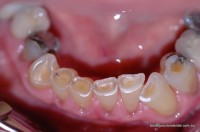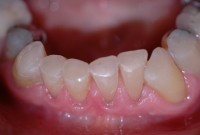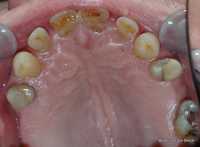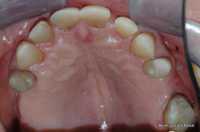Worn Dentition and Saliva
WORN TEETH and ABRASSION
Wear on teeth should be assessed relative to age.
The amount of wear on a person’s teeth may be normal for that person at that time of their life.
Excessively worn teeth makes a person’s appearance look older.
A younger facial appearance can be achieved by bonding tooth coloured material to teeth to replace worn away tooth structure.
Bonding to worn teeth will also protect against further wear. Treatment is easy as only usually only cleaning the tooth surface is required and no tooth structure needs to be ground away or removed.
Worn teeth do not function as efficiently due to poorer cutting efficiency when teeth get flatter and loose their normal shape. Tooth wear accelerates throughout life once the harder outer enamel layer is worn away exposing the softer inner dentine layer. Teeth can become sensitive or sore once dentine is exposed.
In excessive cases wear can expose the nerve requiring a nerve treatment.
Worn, short, stumpy teeth become an aesthetic problem. Short teeth are difficult to restore as there is little tooth structure for bonding or for cementing a crown. It is best to try to prevent wear than try to treat teeth once teeth are excessively worn.
Crown Lengthening
Teeth with little tooth structure remaining above the gum line, due to wear or fracture, may need to be ‘crown lengthened’ before the teeth can be restored or crowned.
Crown lengthening involves removing about about 2-3mm of bone around the neck of the tooth and re-positioning the gum at a lower level. This technique allows more tooth strcuture to stand out above the gum line so that it can be crowned or bonded to. Crown lengthening is a minor surgical procedure.
Attrition:
Attrition is wear on the chewing or incisal surface of teeth.
Abrasion:
Abrasion is wear on the sides of teeth and usually presents as a ‘V’ or ‘C’ shaped groove on the outer surfaces of teeth near the gum line. These areas are often sensitive to acidic drinks, hot and cold foods or when breathing in air through the mouth.
Accelerated Wear Through Attrition and Abrasion
Teeth may show excessive wear relative to a persons age due to:
- Heavy bruxing (tooth grinding) habits during sleep or clenching habits during the day.
- Excessively vigorous brushing with a hard brush
- Natural teeth biting against harder materials such as crowns or porcelain inlays can accelerate wear.
- Acidic foods soften tooth surfaces at a microscopic level.
An otherwise normal amount of grinding on an acid affected tooth surface will result in acclerated wear. It is advised to limit excessive intake of acidic foods such as grapefruit, lemons and oranges and acidic rinks drinks such as cola drinks, sports drinks, wines and fruit juices. Rinse with water after eating acidic foods and drinks to dilute acid in the mouth.
SALIVA
Salivary Flow affect wear rates
- Certain diseases causing reduced salivary flow
- Many medications cause reduced salivary flow
- Natural ageing can cause reduced salivary flow
- Chronic dehydration in elite athletes and insufficient re-hydration reduces salivary flow.
- Excessive intake of acidic sports and cola drinks accelerates wear by softening teeth surfaces.
- Excessive caffeine intake can act as a diuretic reducing the salivary flow.

Worn lower front teeth

Bonding on edges of worn teeth
Role of Saliva:
Teeth surfaces when in an acidic environment from either bacteria living in plaque or from acidic foods and drinks causes the tooth surface to soften. Repeated softening will result in decay or accelerated wear.
Saliva is protective to tooth structure.
Any decrease in quality or volume of saliva will increase wear and decay rates. Normal saliva bathes teeth in a super-saturated solution of calcium and phosphate ions. The Calcium and phosphate ions are absorbed by the tooth surface making the tooth surface harder and less likely to wear and decay.
Saliva neutralises acidic foods and acids produced by decay causing bacteria through it’s ability to dilute acids and buffering (ability to convert acid into a neutral solution) ability. The sooner saliva returns to a normal ph (measure of acidity) the less wear and decay takes place. Patients with poor quality saliva and poor salivary flow will have greater wear and decay rates because their teeth remain in an acidic environment longer than normal.
Patients who complain about a dry mouth will also have poor quality saliva and salivary volume. Dry mouth may occur or made worse through disease, ageing or medication. Without adequate salivary flow, patients with dry mouths may never be able to return to normal oral ph levels. These mouths will often have a perpetually acidic oral environment. resulting in rampant tooth decay. Patients with dry mouth need to be monitored very closely and preventive measures instituted early.
Saliva Tests
A saliva tests can be performed to establish a base rate for salivary function when we suspect a patient’s salivary function is not adequate, This gives Dr Deutsch a better understanding as to the patient’s likely future decay and wear rates and the level of intervention needed to control their problem.
TREATMENT FOR DRY MOUTH and WORN TEETH
Treatment includes some or all of the items below:
- Diet: A reduction in acidic foods / drinks such as juice, wine, coke, sports drinks is essential. Even rinsing with wate after having something acidic will help neutralise mouth acidity. Drinking more water is very important.
- For athletes: Wait before you brush teeth after doing heavy exercise. Use of a soft toothbrush and brushing teeth only after a period or re- hydration.
- Medication: may have to be altered if causing excessive dry mouth.
- Re-mineralisation: use topical applications of calcium, phosphate and fluoride for 2 weeks to harden tooth surfaces and improve bonding prior to placing restorations.
- Medicament trays:A small flexible tray, thinner than a mouthguard can be made to hold re-mineralising agents on teeth for longer periods than is possible by just applying agents topically.
- Special chewing gums with added calcium and phosphates are available.
Normal sugarless chewing gum will also help by stimulating salivary flow and aid re-mineralisation. - Artificial saliva and saliva stimulants may be prescribed to simulate natural saliva.
- Rinsing: Patients with poor salivary flow should rinse with water after meals and in severe cases rinsing with a teaspoon of baking soda in a glass of water is advised to return saliva ph. back to normal.
- Bonding:Bonding tooth coloured filling material onto excessively worn areas will protect worn surfaces. Occasionally crowns and porcelain inlay/onlays may be required.
- Occlusal Splint or Night Guard: An occlusal splint may be made to be worn at night to help control wear from grinding (bruxing) during sleep.

